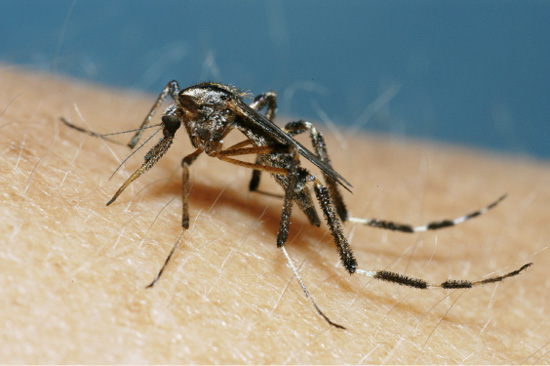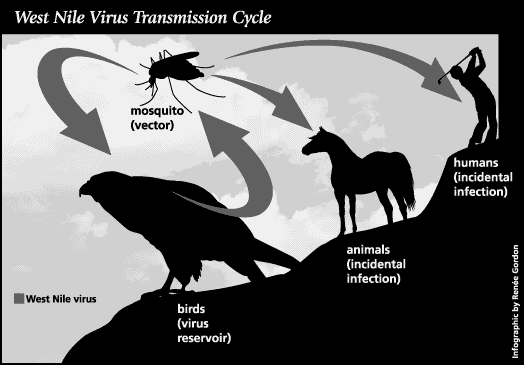Mosquitoes, West Nile, and Other Encephalitis Viruses: What You Can Do to Protect Yourself
Mississippi has 60 species of mosquitoes, but only five or six of them are significant pests. Most are relatively rare and associated with a narrow host range or unusual ecological niche. For example, some species feed only on frogs, so they have little or no interaction with humans, and others live only in certain pitcher plants along the Gulf Coast. The major pest mosquitoes in Mississippi are those that breed in high numbers and are important because of nuisance biting and/or disease transmission.

Mosquito Life Cycle
All mosquitoes have a four-stage life cycle that includes egg, larva, pupa, and adult (see Figure 2).

1. egg raft and single egg
2. second instar larva
3. fourth instar larva
4. pup
(Drawing courtesy Joe MacGown, Research Technician and Scientific Illustrator, Agricultural Science and Plant Protection.)
Mosquito females generally deposit from 50 to 400 eggs on or near water surfaces that range from relatively clear water to very polluted water, depending on the species. This might include artificial containers, storm sewer catch basins, clogged street drains, water accumulations in low areas, open or leaking septic tanks, and drains from sewage disposal plants or lagoon systems. In most cases, clear water that doesn’t have organic matter or algae growth is not attractive to female mosquitoes.
Eggs hatch in 24 to 48 hours. Hatched larvae, known as “wigglers,” use algae or decaying organic matter for food. If conditions are good, the larvae pass through four larval instars in 5 to 7 days.
First instar larvae are very small and require magnification just to determine they are mosquito larvae. First, second, and third instar larvae actively feed, while the fourth instar is a nonfeeding stage. Following larval development, a nonfeeding pupal stage forms that lasts 1 to 2 days before adult emergence. Thus, development from egg to adult may occur in 8 to 10 days in warm weather.
Adult mosquitoes may live from 3 to 6 weeks or more. When not actively searching for food, adults may rest in protected sites such as animal burrows, buildings, shrubs, other low-growing vegetation, dense forested areas, culverts, or similar cool, shaded areas.
Mosquitoes Affect Health
Mosquitoes affect human health by nuisance biting (the pain and aggravation of bites) and by carrying certain disease agents. They can serve as disease transmitters (vectors) because of their blood-feeding habit. In fact, mosquitoes get disease-causing germs from humans and other animals during blood-feeding and later transmit them to people or other hosts.
Mosquitoes carry malaria, dengue, yellow fever, and also more recent diseases such as Zika, West Nile virus (WNV), St. Louis encephalitis (SLE), and LaCrosse (LAC) encephalitis. Fortunately, malaria, dengue, and yellow fever have been eliminated from the United States, although cases are occasionally imported as people travel internationally. WNV, SLE, and LAC viruses are called “encephalitis viruses” because they may lead to inflammation and swelling of the brain. Note: encephalitis may be caused by other factors besides mosquito-carried viruses.
WNV is the newest of the encephalitis viruses carried by mosquitoes in the United States and has been reported in Mississippi in horses, birds, mosquitoes, and humans. WNV is actually a bird disease that only occasionally “spills over” to horses and humans. Many mosquito species have been found naturally infected with WNV, but the main vector (carrier) in Mississippi is the southern house mosquito, Culex quinquefasciatus.
Most people who get bitten by a WNV-infected mosquito never get very sick but just feel headachy or feverish for a few days. In more serious cases, symptoms occur 4 to 10 days after being bitten by an infected mosquito and include fever, headache, muscle aches, and nausea or vomiting. These may progress to seizures, paralysis, coma, and possibly death. Those who survive can suffer permanent health effects such as memory loss, paralysis, or personality changes.
Anybody can contract WNV, but people over 50 years of age and those with weakened immune systems have more severe cases of the disease. The mortality rate for WNV is approximately 3 to 15 percent. Certain species of birds, especially crows and blue jays, as well as horses, can also get sick and die from WNV.

St. Louis encephalitis primarily affects the elderly. Symptoms are very similar to those of West Nile virus. Only a doctor can tell them apart.
Also, the mosquito vector for SLE in Mississippi is the same as that of WNV, the southern house mosquito. The disease rarely causes death, although approximately 15 percent of patients with severe symptoms may die. SLE can erupt in large outbreaks. In the mid-1970s, more than 300 cases of SLE occurred in Mississippi, resulting in 36 deaths.
LaCrosse encephalitis is most common in the upper midwestern United States but has increasingly been reported in Mississippi in recent years. Most cases occur in children younger than 16 years of age. One of the main signs of LAC is seizure in infected children. LAC is relatively mild; only about 1 percent of people infected with the virus die. The primary vector of LAC is the tree-hole mosquito, Aedes triseriatus.
Protect Yourself
Personal protection against mosquitoes helps prevent not only West Nile infection but also other mosquito-borne diseases, such as SLE and LAC. Mosquitoes transmit diseases by their bites, through germs in their saliva. Protection should be aimed at reducing mosquito numbers around the home and preventing bites.
Reduce Mosquito Populations Around the Home
The first step in protecting yourself from mosquito bites is to make sure you aren’t contributing to your own problem. Walk through your yard looking for potential mosquito breeding sites. All the mosquito needs to breed is some water containing a few leaves or a small amount of organic matter. In as little as a week, water can produce mosquitoes.
Examples of mosquito breeding sites around the home include old tires, buckets, wheelbarrows, cans, tarps over pools or boats, or anything else that holds water for a week or so after rain. Clean gutters regularly and birdbaths at least weekly. Drill holes in the bottoms of tire swings so they can drain. Drain low areas in the yard or fill with soil or gravel to eliminate standing water.
Prevent Mosquito Bites
Protection from mosquitoes can be either physical or chemical. Physical barriers include tight-fitting screen wire to cover windows and doors, netting when camping or sleeping outdoors, and thick, long-sleeved shirts or long pants. The goal is to prevent mosquitoes from landing on or biting you. The less exposed skin, the less opportunity for mosquitoes to bite.
Chemical protection involves using insect repellents. Many repellents are available. Most contain the active ingredient DEET, though other repellents include newer chemical products, such as picaridin or the “natural” (herbal-based) products such as oil of lemon eucalyptus. Natural, herbal-based repellents may be effective, but only for a short time, compared to DEET repellents. Although some people are afraid of DEET repellents because of a few reports of adverse reactions, the products have a good track record for safety. As is the case with all pesticides and repellents, mosquito control products should be used only according to their label directions.
The information given here is for educational purposes only. References to commercial products, trade names, or suppliers are made with the understanding that no endorsement is implied and that no discrimination against other products or suppliers is intended.
Publication 2530 (POD-02-25)
By Jerome Goddard, PhD, Extension Professor, Agricultural Science and Plant Protection.
The Mississippi State University Extension Service is working to ensure all web content is accessible to all users. If you need assistance accessing any of our content, please email the webteam or call 662-325-2262.


